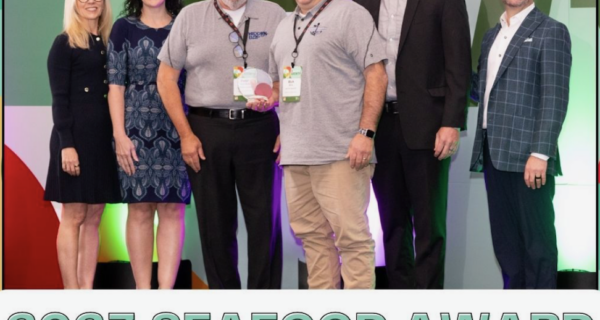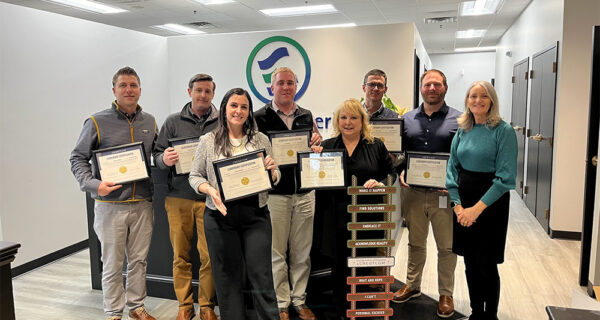Welcome to the Eastern Fisheries’ Buyers Website. This site will provide you with the product information, market news, sales tools, and resources that will help you reach your goal to exceed your customer’s seafood expectations.
Our Products
Eastern Fisheries takes great pride in the fact that our seafood comes direct from the ocean to you.
Less handling means a higher quality product at the best possible value.
Recent News
Read through the latest industry news.
EASTERN FISHERIES RECEIVES 2023 SEAFOOD SUPPLIER AWARD
Eastern Fisheries was presented with the 2023 Protein & Seafood Supplier of the Year award from IMA Foodservice. …
EASTERN FISHERIES EXECUTIVE TEAM ACHIEVE LEADERSHIP CERTIFICATION
Eastern Fisheries announced today, seven members of their executive team successfully completed Crestcom’s Leadership Training program. Joseph Marshall,…
ERIC GRIVA NAMED EASTERN FISHERIES 2023 EMPLOYEE OF THE YEAR
Eastern Fisheries congratulates Eric Griva, 2023 Employee of the Year. “Eric has been a great addition to the…
Sign up for the Quarterly Market Newsletter
FAQs
Lorem ipsum dolor sit amet, consectetur adipiscing elit. Nam sollicitudin nisi cursus, aliquet mauris vitae, convallis ligula. Sed suscipit neque ut rutrum consectetur. Fusce ut ex elit.
Curabitur hendrerit nunc nibh, in rutrum augue suscipit quis. Ut blandit ex lacus, venenatis hendrerit sem hendrerit sit amet. Nullam blandit congue imperdiet. In at metus congue, posuere risus quis, interdum diam.
Quisque placerat viverra risus condimentum blandit. Vestibulum ac tincidunt dui. Integer porta sollicitudin tortor, vitae fermentum felis tempor lacinia.
Atlantic scallops typically spawn in the warmer weather, late summer into early fall. Sometimes it can occur with spawning taking place in the spring and then again in late August or early September. During this time the scallop’s energy is utilized for spawning, the scallops purge a milky liquid leaving the scallop meat to be less firm. Scallops can go from completely ripe to completely spent in less than a week. This natural occurrence does not affect the flavor of the scallops.
This gassy odor is completely normal. When scallops are caught and shelled it takes some time for the dissolved gasses to leave the scallop mussel (the part we eat). Since they are caught, shucked and packaged in a very short time they “off-gas” inside the sealed containers. This can cause a mild, gassy odor when you first open the sealed container. This “gassy” odor should not linger and once the container has been opened the scallops should have a slightly sweet ocean smell.
Although they are shellfish, fresh scallops should not smell fishy. Rather, they should give off a sweet, seaweed aroma. If the fish odor is strong, discard them.
Scallops can naturally take on an orange hue, sometimes pinky-peach to deep orange. This orange hue is caused by an excess of a natural pigment called zeaxanthin in the female scallop. As the gonad ripens and takes on an orange tint any overabundance of this pigment is transported into the adductor muscle (the part we consume). Meat quality and taste is not affected at all and some have reported that the orange scallops are slightly sweeter.
Typically the Atlantic Scallop season begins in March and goes straight through to December. The bulk of scallops are harvested between May and July.
Anytime is a good time to buy scallops. Domestic scallops are harvested all year long, however spawning usually takes place in April for the Atlantic Scallop and this can sometimes produce a scallop that is less firm.
Eastern Fisheries own and operates 27 fishing vessels, the largest fleet in the scallop industry.
View all of the boats on the Vessels page of the Eastern Fisheries website.
The Japanese Hokkaido fishery is the largest in the world. Harvest begins in May. The Japanese scallop is the closest in size and taste to the domestic scallop.
Peruvian scallops harvests primarily in the fall, September through November. The scallop sizes are slightly smaller at 20/30, 30/40, 40/60 and 60/80 counts.
Cultivated China bays scallops are harvested between November and December.
The “sweet meat” on a scallop, also referred to as the “catch” is a crescent shaped piece of harder tissue that is attached to one side of the scallop meat. This is usually removed in the shucking or cleaning process, but if you have a few scallops with the sweet meat still attached it should be removed prior to cooking otherwise it will get incredibly tough.
If packaged correctly frozen IQF scallops have a 24-month shelf life. Fresh scallops, kept in the coldest part of your cooler, have a two-day shelf life.
Longline refers to the harvest method. This method uses a very long main line with many hooks attached, it is submerged in the ocean using weights. Lines can stretch out for miles. Typically longline fish are handled less than fish caught in a trawl net so they tend to have less imperfections.
Market cod and scrod are the same species, usually scrod refers to the smaller cut and market refers to a slightly larger cut.
Frozen-at-sea. Because frozen at sea fish is frozen immediately after it is caught, it is often fresher at time of thawing than fresh fish that was purchased a day or two after is was caught.
If the fish is properly packaged the frozen shelf life is 24 months.
Our flounder and sole is caught in Alaska. The product is then shipped to our factory in China, where it is cleaned, inspected, filleted and frozen. FDA regulations dictate that the country of origin needs to be the place where the product was transformed. Because the product is processed and undergoes a substantial transformation at our plant in China, by law we need to use “product of China” on our product labeling.




